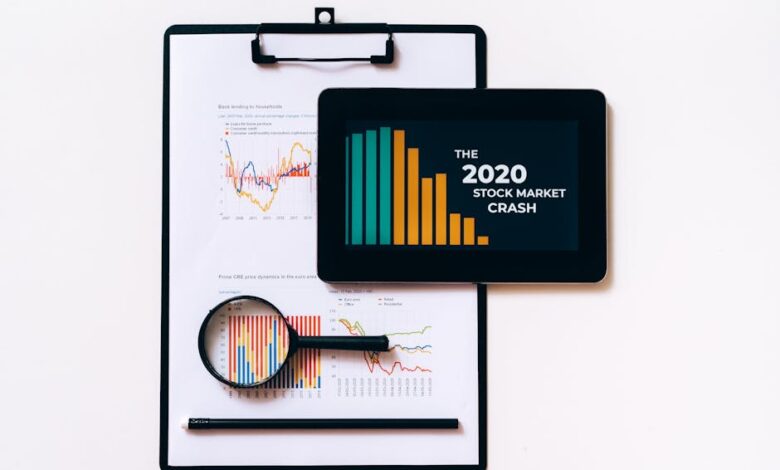Weathering the Storm: Understanding Recession Signals, Investment Strategies, and Government Responses

As the global economy fluctuates, the specter of recession looms as a formidable challenge for businesses, investors, and consumers alike. Understanding the early warning signs of an economic downturn is crucial for proactive decision-making, as these indicators can provide invaluable insights into the health of various sectors. From shifts in consumer behavior to the impact on global trade and supply chains, recessions have far-reaching consequences that extend beyond mere financial metrics.
In this article, we will explore the early red flags that signal a potential recession, examine how different sectors respond to economic contractions, and discuss strategies for investing wisely during these turbulent times. Additionally, we will delve into the role of government stimulus measures in mitigating the effects of a recession and highlight lessons learned from past economic downturns that remain relevant today. By equipping businesses and individuals with the knowledge to prepare for and navigate recessions, we aim to foster resilience in the face of economic uncertainty.
- 1. Recognizing the Red Flags: Early Warning Signs of an Economic Recession
- 2. Navigating the Downturn: Strategies for Investing in a Recession
- 3. Government Interventions: The Role of Stimulus in Economic Recovery
1. Recognizing the Red Flags: Early Warning Signs of an Economic Recession
Recognizing early warning signs of an economic recession is crucial for businesses, investors, and policymakers alike. Several indicators can signal an impending downturn, allowing stakeholders to take proactive measures.
One primary red flag is a decline in consumer spending, which accounts for a significant portion of economic activity. When households begin to cut back on expenditures, it often points to decreased confidence in the economy. This reduction can be observed through falling retail sales figures or a drop in consumer confidence indexes.
Another warning sign is the behavior of the stock market. A sustained decline in stock prices, particularly in leading sectors, can indicate that investors are anticipating lower corporate profits due to reduced consumer demand. Additionally, increased volatility in the markets can reflect uncertainty about future economic conditions.
Rising unemployment rates also serve as a crucial signal. When job losses begin to mount, it can lead to a downward spiral in consumer spending, as unemployed individuals tend to cut back on discretionary purchases. Similarly, a slowdown in hiring or a surge in initial jobless claims can foreshadow economic trouble.
Changes in manufacturing activity are another important indicator. A decline in manufacturing output, as evidenced by decreasing Purchasing Managers’ Index (PMI) readings, can suggest that businesses are scaling back production in response to reduced demand. This contraction can have ripple effects throughout the supply chain, further impacting economic growth.
Additionally, tightening credit conditions, reflected in higher interest rates or stricter lending standards, can signal an approaching recession. When banks become more cautious about lending, it can restrict access to capital for both consumers and businesses, limiting spending and investment.
Finally, external factors such as geopolitical tensions, rising commodity prices, or significant changes in fiscal policy can also contribute to economic instability. Monitoring these variables is essential for recognizing the potential onset of a recession.
By staying vigilant and attentive to these early warning signs, stakeholders can better prepare for the challenges that accompany economic downturns, allowing for more informed decision-making in uncertain times.
2. Navigating the Downturn: Strategies for Investing in a Recession
Investing during a recession requires a strategic approach that prioritizes capital preservation while seeking opportunities for growth. One of the key strategies is to focus on defensive stocks—companies that provide essential goods and services, such as utilities, healthcare, and consumer staples. These sectors tend to be less sensitive to economic fluctuations, allowing investors to maintain a level of stability in their portfolios.
Another effective strategy is to consider dividend-paying stocks. Companies that have a history of consistent dividend payments often have strong balance sheets and can provide a reliable income stream even during economic downturns. This can be particularly appealing when market volatility increases, as dividends can help cushion losses.
Investors might also explore fixed-income securities, such as government bonds, which are generally considered safe havens during turbulent times. High-quality bonds tend to retain value when equities decline, providing a counterbalance to potential losses in stock investments.
Real estate can also present opportunities during a recession, particularly in niche markets such as rental properties. Demand for affordable housing often remains stable, and well-located rental properties can provide consistent cash flow. However, it is essential to carefully assess the local market conditions before making such investments.
Additionally, investors should consider diversifying their portfolios to mitigate risk. This could involve spreading investments across various asset classes, sectors, and geographic regions to reduce exposure to any single economic downturn.
Finally, maintaining liquidity is crucial. Keeping a portion of the portfolio in cash or cash-equivalents allows investors to take advantage of attractive buying opportunities that may arise as market prices decline. By being prepared to act quickly, investors can capitalize on lower valuations during a recession.
In summary, while recessions can be challenging for investors, employing a mix of defensive strategies, focusing on quality assets, and maintaining liquidity can help navigate the downturn effectively.
3. Government Interventions: The Role of Stimulus in Economic Recovery
Government interventions play a crucial role in mitigating the effects of economic recessions, with stimulus measures often being at the forefront of recovery efforts. Stimulus packages are designed to inject liquidity into the economy, stimulate demand, and support both consumers and businesses during downturns. These measures can take various forms, including direct cash payments to individuals, expanded unemployment benefits, tax relief, and funding for infrastructure projects.
One of the key objectives of government stimulus is to boost consumer spending, which often declines during a recession due to increased uncertainty and reduced disposable income. By providing financial assistance, governments aim to enhance consumer confidence and encourage spending, which is essential for driving economic growth. Additionally, stimulus spending on infrastructure and public services can create jobs and stimulate demand in various sectors, further promoting recovery.
Moreover, targeted interventions can support specific industries that are particularly hard-hit during recessions, such as travel, hospitality, and retail. By providing grants or low-interest loans to these sectors, governments can help businesses remain viable, preserve jobs, and maintain the overall health of the economy.
The effectiveness of government stimulus can vary based on the scale and timing of the interventions. Rapid and substantial responses, as seen during the COVID-19 pandemic, can lead to quicker recoveries, while delayed or insufficient measures may prolong economic downturns. Additionally, the long-term impact of stimulus spending on national debt and inflation must be carefully considered to ensure sustainable economic growth.
In summary, government stimulus plays a vital role in economic recovery by bolstering consumer spending, supporting struggling industries, and creating jobs. The success of these interventions depends on their design, implementation, and the broader economic context in which they are deployed.
In conclusion, understanding and preparing for the inevitability of economic recessions is crucial for individuals, businesses, and governments alike. By recognizing the early warning signs, such as declining consumer confidence and rising unemployment rates, stakeholders can take proactive measures to mitigate the effects of downturns. While recessions present unique challenges across various sectors—impacting everything from retail to global trade—the strategies outlined for investing during tough times can provide opportunities for growth and resilience.
Government stimulus plays a pivotal role in cushioning the blow of recessions, fostering recovery, and stabilizing markets. However, the effectiveness of such interventions often depends on the swift and targeted nature of the response. Additionally, consumer behavior shifts during economic downturns, significantly influencing market dynamics and demand for goods and services.
Lessons learned from past recessions—such as the importance of financial prudence and the need for adaptive strategies—remain relevant today as we navigate an increasingly interconnected global economy. By preparing for potential challenges and adopting flexible business practices, companies can not only survive but thrive despite economic uncertainties.
Ultimately, a comprehensive understanding of these elements equips us to face future recessions with greater confidence and resilience, ensuring that both individuals and businesses can weather the storm and emerge stronger on the other side.





